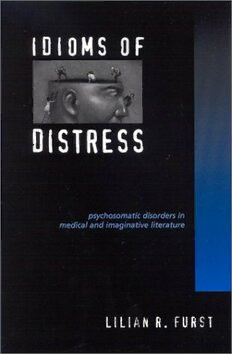
Idioms of Distress: Psychosomatic Disorders in Medical and Imaginative Literature PDF
Preview Idioms of Distress: Psychosomatic Disorders in Medical and Imaginative Literature
IDIOMS OF DISTRESS Idioms of Distress Psychosomatic Disorders in Medical and Imaginative Literature By Lilian R. Furst STATE UNIVERSITY OF NEW YORK PRESS Published by State University of New York Press, Albany © 2003 State University of New York All rights reserved Printed in the United States of America No part of this book may be used or reproduced in any manner whatsoever without written permission. No part of this book may be stored in a retrieval system or transmitted in any form or by any means including electronic, electrostatic, magnetic tape, mechanical, photocopying, recording, or otherwise without the prior permission in writing of the publisher. For information, address State University of New York Press, 90 State Street, Suite 700, Albany, NY 12207 Production by Christine L. Hamel Marketing by Anne Valentine Library of Congress Cataloging in Publication Data Furst, Lilian R. Idioms of distress : psychosomatic disorders in medical and imaginative literature / Lilian R. Furst. p. cm. Includes bibliographical references and index. ISBN 0-7914-5557-2 (hbk.: alk. paper) — ISBN 0-7914-5558-0 (pbk.: alk. paper) 1. Medicine, Psychosomatic. 2. Literature and mental illness. 3. Imagination in literature. 4. Diseases in literature. I. Title. RC49.F87 2002 616.08—dc21 2002017723 10 9 8 7 6 5 4 3 2 1 Wer Augen hat zu sehen and Ohren zu hören, überzeugt sich, dass die Sterblichen kein Geheimnis verbergen können. Wessen Lippen schweigen, der schwätzt mit den Fingerspitzen; aus allen Poren dringt ihm der Verrat. Und darum ist die Aufgabe, das verborgenste Seelische bewusst zu machen, sehr wohl lösbar. He that has eyes to see and ears to hear may convince himself that no mortal can keep a secret. If his lips are silent, he chatters with his finger-tips; betrayal oozes out of him at every pore. And thus the task of making con- scious the most hidden recesses of the mind is one which it is quite possible to accomplish. —Freud,Bruchstück einer Hysterie-Analyse(Dora) Contents Preface ix Hiding and Seeking Distress 1.Speaking through the Body3 2. Swings of the Historical Pendulum 19 3. The Mysterious Leap 37 4. Literary Patients 53 Metaphors of Distress 5. “A Strange Sympathy betwixt Soul and Body”: Nathaniel Hawthorne, The Scarlet Letter(1850)73 6. Nerves: At the Interstices of Physiology and Psychology: Emile Zola, Thérèse Raquin(1867) 93 7.“A Sick Spot on the Body of the Family”: Thomas Mann, Buddenbrooks(1900) 111 8. “Legs Turned to Butter”: Arthur Miller, Broken Glass(1994) 129 9. Substance and Shadow: Brian O’Doherty, The Strange Case of Mademoiselle P. (1992) 149 10. Shell Shock: Pat Barker, Regeneration(1991) 169 11. Outing the Distress 191 Notes201 Bibliography 211 Index 221 vii Preface “It’s all in your head”; “Isn’t that what women are supposed to get?” These two responses to the word “psychosomatic” (incidentally, from well-educated individuals) are vivid illustrations of the uncertainties sur- rounding both the term and the concept. Neither formulation is wholly incorrect: the “head” (i.e., the mind) plays a cardinal role in psychosomatic disorders, and the gender ratio is weighted on the female side.1Yet each of these phrases is at best only partially valid; the one carries an undertone of dismissiveness, while the interrogatory form of the other indicates hesitancy. Why are psychosomatic disorders so resistant to ready understanding? Their recalcitrant nature is due in part to their multivalence; chameleon- like, they can assume many different guises, appearing in every part of the body, although some, such as headaches and stomachaches, are more common than others. Also, they are hard to diagnose, for they do not yield signs of pathological changes in test results. They remain elusive, cryptic, posing a challenge to sufferers and physicians alike. And beyond their overt, often puzzling manifestations, psychosomatic disorders encompass a deeper problem in their close intertwining of psyche and soma, as their name suggests. Yet the term itself is not a rarity. We apply it, with a wry smile, to a sudden headache, for instance, brought on by an annoying encounter that has rubbed us up the wrong way. By recognizing the headache as psycho- somatic, we perceive it as a physical outcome of, that is, an outlet for, an emotional state. We know that it is not purely imaginary: it is real—we may take Tylenol or Advil or whatever pain medication we prefer. We do not immediately believe it to be a symptom of a grave pathological disturbance such as a brain tumor. But how are mind and body interacting? By what paths is the annoyance translated, converted into the headache or the stomachache or some other symptom? While recent advances in the ix
